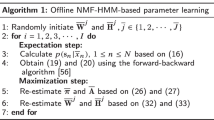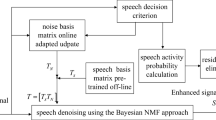Abstract
This paper presents a framework of HMM parameter adaptation technique for improving automatic speech recognition (ASR) performance in the noisy environments, which online combines the clean hidden Markov models (HMMs) with the noise model. Based on the given composite HMM corresponding to the initial recognition pass result and truncated vector Taylor series, the noise model in the cepstral domain is updated and refined using iterative Expectation-Maximization (EM) algorithm under maximum likelihood (ML) criterion. Experiments results show that the presented approach in this paper is found to greatly improve recognition performance under mismatched conditions.
Preview
Unable to display preview. Download preview PDF.
Similar content being viewed by others
References
Moreno, P.J., Raj, B., Stern, R.M.: A Vector Taylor Series Approach for Environment-Independent Speech Recognition. Proceedings of IEEE, 733–736 (1995)
Kim, N.S.: Statistical Linear Approximation for Environment Compensation. IEEE Signal Processing Letters 1, 8–10 (1998)
Shen, H., Liu, G., Guo, J., Li, Q.: Two-Domain Feature Compensation for Robust Speech Recognition. In: Wang, J., Liao, X.-F., Yi, Z. (eds.) ISNN 2005. LNCS, vol. 3497, pp. 351–356. Springer, Heidelberg (2005)
Shen, H., Guo, J., Liu, G., Huang, P., Li, Q.: Environment Compensation Based on Maximum a Posteriori Estimation for Improved speech Recognition. In: Gelbukh, A., de Albornoz, Á., Terashima-Marín, H. (eds.) MICAI 2005. LNCS (LNAI), vol. 3789, pp. 854–862. Springer, Heidelberg (2005)
Gales, M.J.F.: Model-Based Techniques for Noise Robust Speech Recognition. Ph.D. thesis, University of Cambridge (1995)
Acero, A., Deng, L., Kristjansson, K., Zhang, J.: HMM Adaptation Using Vector Taylor Series for Noisy Speech Recognition. In: Proceedings of ICSLP 2000 (2000)
Dempster, A.P., Laird, N.M., Rubin, D.B.: Maximum likelihood from incomplete data via the EM algorithm. J. of the Royal Statistical Society B 39, 1–38 (1977)
Zu, Y.Q.: Issues in the Scientific Design of the Continuous Speech Database. Available, http://www.cass.net.cn/chinese/s18_yys/yuyin/report/report_1998.htm
Varga, A., Steenneken, H.J.M., Tomilson, M., Jones, D.: The NOISEX–92 Study on the Effect of Additive Noise on Automatic Speech Recognition. Tech. Rep. DRA Speech Research Unit (1992)
Author information
Authors and Affiliations
Editor information
Editors and Affiliations
Rights and permissions
Copyright information
© 2005 Springer-Verlag Berlin Heidelberg
About this paper
Cite this paper
Shen, H., Li, Q., Guo, J., Liu, G. (2005). HMM Parameter Adaptation Using the Truncated First-Order VTS and EM Algorithm for Robust Speech Recognition. In: Hao, Y., et al. Computational Intelligence and Security. CIS 2005. Lecture Notes in Computer Science(), vol 3801. Springer, Berlin, Heidelberg. https://doi.org/10.1007/11596448_145
Download citation
DOI: https://doi.org/10.1007/11596448_145
Publisher Name: Springer, Berlin, Heidelberg
Print ISBN: 978-3-540-30818-8
Online ISBN: 978-3-540-31599-5
eBook Packages: Computer ScienceComputer Science (R0)




